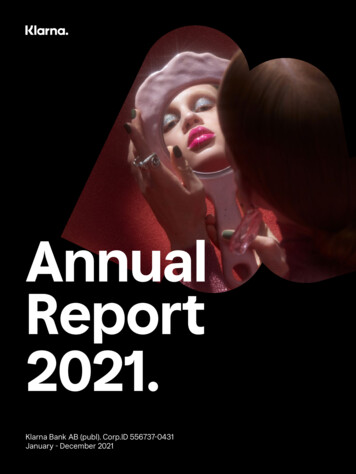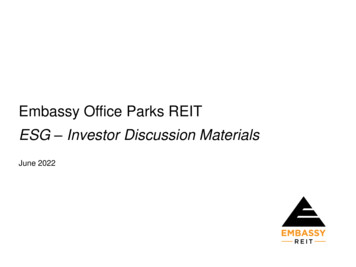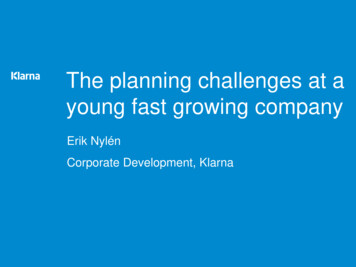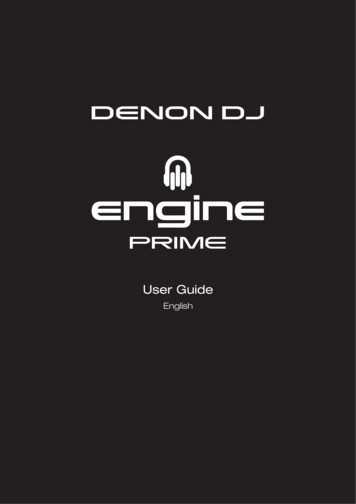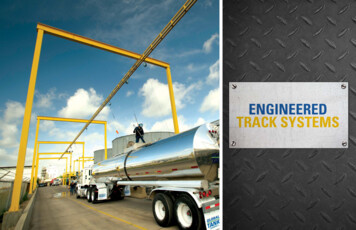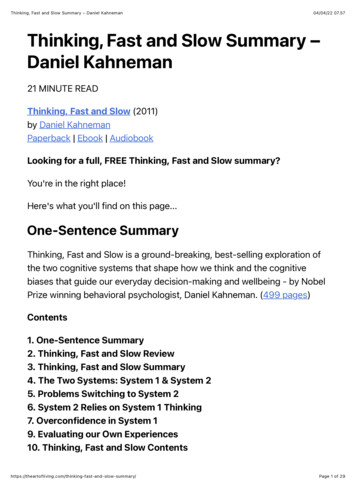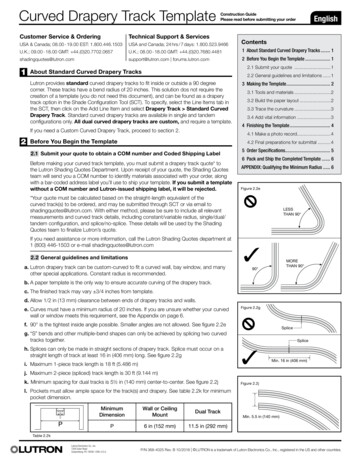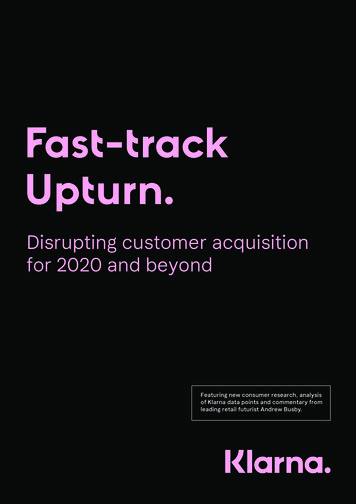
Transcription
Fast-trackUpturn.Disrupting customer acquisitionfor 2020 and beyondFeaturing new consumer research, analysisof Klarna data points and commentary fromleading retail futurist Andrew Busby.
Executive summary.It’s no secret that retailers always want to gain and retain morebusiness. In a post-COVID-19 world it will become vital. The paradox ishow to do this while keeping Customer Acquisition Costs (CAC) low,lifting Customer Lifetime Value (CLV) and boosting propensity to buy.Finding new ways to do this will be vital for a fast retail recovery.This paper explains how historic CLV perspectives are holding modern retailers back fromrealising their full potential. It outlines new models for success including the ‘Klarna Effect’,what it means and how it can stimulate a re-investment loop that delivers greater ROI forcustomer-facing marketing strategies.Why it’s a ‘must read’: We explore the challenges retailers face andwhy they have to think differently about howthey measure success. Encourage retailers to discover new and betterways to drive acquisition. Drawn from the insights of 2,000 shoppers, wereveal where retailers should be spending moneyfreed from acquisition. Giving them deep marketinsight to help win revenue, drive ‘gain-andretain’ engagement engines and fulfil their growthpotential in the next decade and beyond. Discuss new engagement approaches forconversion, loyalty and advocacy to boost CLV.Impact of Coronavirus (COVID-19).All retailers have been affected by the COVID-19crisis but undoubtedly physical retailers acrossevery category have been hit the hardest.While no-one knows how long it will take forrevenue levels to bounce back, we are certainthat understanding customers and metricsaround sales performance will be crucial onthe road to economic recovery.In Australia we know that customers havenever been more demanding or better informed.The rapid growth of eCommerce means they’reshopping around the clock and when makingFast-track Upturn June 2020buying decisions they are impatient and drivenby their personal values.And as retailers re-formulate their strategicroadmaps, establishing more accurate costmodels, and crucially identifying new waysto create revenue upturn, will be vital to theirregeneration. We hope that this paper canprovide some fresh insight on the topic of CLV,helping them to hack sales growth and get backon their feet faster.Matt Scott, Commercial Lead, Australia
Foreword.Andrew Busby, top 20 global retail influencer, CEO of Retail Reflections and IBM Futurist.2020 promises to usher in even moredemanding and connected consumers.Retailers will have to adopt new, moreeffective approaches to align brandswith their customers. Clinging toobsolete models, based on outdatedcustomer behaviours, will not beenough to keep customer value alive.It’s time for an engagementdriven approach.Traditional methods to establish customer valueand cost rely on sales-first retail models, conceivedyears before digital and social took hold andgenerally based on historical data and traditionalmarketing campaigns.Today’s consumer has more options than everbefore. So, applying traditional metrics to a nontraditional consumer is planning for failure.Emotional connection is now a more significantdriver of sales than price or product. Optimisingacquisition costs, allowing brands to better investin customer engagement and advocacy, is nowthe most effective way of tracking a customer’spropensity to spend (and in raising it).The power of partnership.Where retailers might once have invested heavily inadvertisers or affiliates to acquire customers, smartretailers are switching the focus to optimising newstrategic partnerships, with service providers thatdeliver big benefits.Klarna is one of those providers. With Klarna, retailerscan ‘hack’ the acquisition process, gaining immediateaccess to pre-engaged and already-loyal Klarnaconsumers at a significantly lower cost than if theyhad to go out and acquire new customers. Klarnalowers upfront acquisition costs, which increases totallifetime value by allowing retailers to focus the savedmoney on nurturing and advocacy.What’s more, the unique combination of convenience,brand appeal and user experience delivered by Klarnasignificantly boosts engagement, positive sentimentand propensity to spend over time.Andrew BusbyFounder and CEO of Retail Reflections.3
Measuring customer valuein an evolving market.The first step is understanding CAC.The key to understanding customer profitability is knowing the cost to get them hooked in the first place. Forstartups, who need to capture audiences and scale up fast, Customer Acquisition Cost (CAC) is often theirsingle most considerable marketing expense. For established retailers, a high CAC often pairs with a highincidence of churn or weak loyalty. If CAC goes unmanaged, it can inhibit growth or result in an unfeasibly longpayback period (the time the customer needs to be retained before CAC is recovered).CAC is typically calculated as follows:CAC total acquisition spend (per period*)# of customers acquired (per period*)*the period will depend on your business, churn rate and sales/investment cycles.Establishing Customer Lifetime Value (CLV).The CLV estimates how much revenue you can hope to realise once you’ve captured a customer.Traditionally, this is based on typical easy-to-gather sales metrics, including the Average Order Value (AOV)and purchase frequency. These provide an estimate of the average customer’s value to the brand.CLV AOV x Freq (F) x Retention Period (RP) – CACWhat’s wrong with this approach?While this formula has provided retailers with a simple model to gauge success, the calculation is based onhistorical data and a stable market, with consistent engagement and results. It’s no longer relevant to modernomnichannel and pure-play retailers. Dynamic, fast-paced and constantly evolving markets need a newformula that considers more variability – and which reflects the retailer’s ability to influence the consumeremotionally over time, through highly targeted digital, social and CRM-related initiatives.Fast-track Upturn June 2020
A future-focused CLV calculation.Today, we’ve got to think beyond annual revenue per customer to their ‘propensity to spend’, taking intoaccount any future growth potential based on the retailer’s ability to nurture and engage its customers.For example:New CLV propensity to spend ((AOV x F x RP) conversionand revenue uplift advocacy loyalty) – CACHere, propensity to spend is measured by the number of positive customer engagements per annum. At themost basic level, these ‘engagements’ include volume of transactions, but also incorporate softer metricssuch as frequency of engagement with advertising, social media interaction, click throughs and dwell time.An engagement-centric approach to CLV that covers acquisition, conversion,retention and advocacy.This new model of CLV is far more aligned with customers’ omni-channel journeys and how they are thinkingand behaving in 2020. By combining traditional KPIs with new forms of customer intelligence, it encompassesbuying behaviour and brand resonance, which gives a far more accurate measurement of their projectedfuture spend.AcquisitionAdvocacyEngagementcentricCLV modelConversionRetention& loyalty5
Hacking CLV & drivinggrowth with Klarna.What if you could short-circuit the process and reachnew customers quickly and cost-effectively?There are lots of stats showing it’s cheaper and easier to sell to an existing customer than toacquire a new one. While 20-25% of new customers will buy, that rises to 60-70% for existingcustomers. The more customers you keep, the faster you can reap the reward and grow.The Klarna Effect.How it works?Let’s take the traditional sales funnel. Imagine yoursales hopper automatically filled with millions ofcustomers – all primed to buy, empowered to spendand with nothing keeping them out.With Klarna, 85 million global consumers are alreadyenabled and seeking to spend with our pay-lateroptions. They have our app, can use online and instore and are empowered to buy what they want,when they want.With no need to spend on acquisition, the moneysaved can strategically be invested in engaging,nurturing and enticing them to buy more, more oftenand at a higher value.With less effort, time and cost, you can plug anyleaks, remove churn and ensure more consumersreach the bottom of the sales funnel faster – whilespending significantly more with you along the way.Sounds like magic?In the UK, over 7 million consumers have usedKlarna’s payment options; with an average of 88,000new consumers added weekly. Two-thirds are usingKlarna to purchase across multiple retailers in ournetwork. Meanwhile, retail stats show we’re drivingmillions of referrals and outbound traffic from ourowned channels to our retailers per month, as highlyengaged consumers actively seek out Klarna retailersvia our social channels and shop directory.We like to call it the Klarna Effect, which is basedon our observations and data from working withinternational retailers and brands.Delivering a new formula for success.What happens if we import the Klarna Effect into our CLV model? What does it mean for our new future-facingvalue calculation?CLV with KE (Propensity to buy Klarna value uplift) –(CAC – Klarna conversion uplift)Fast-track Upturn June 2020
How does this boost retailer engagement and CLV results?The following table shows how Klarna and its own marketing ‘halo effect’ impacts every element of theretailer’s customer journey, delivering a significant uplift in CLV for modern retailers, especially for thoselooking to reduce CAC and make their business more profitable without impacting growth.So, let’s look at an example of how, drawn from data and analysis based oninternational markets: 4.40 150 149.40Repeatpurchase2 55.00 1001.5 100.00- 10.00 90.001 500.5 00AOVCACCLVAOVCACCLV(Uplift) (Boosted EnhancedConversion)Fast-Fashion RetailerNot using Klarna(Based on retailer transactionresults & customer survey)KlarnaBoostKlarna EffectKlarna growth effectKlarna’s Pay in 4Instalments productFastFashionRetailer44% uplift inacquisition55% increasein AOVPotential for repeat purchase94% repeatpurchase80% activelyrecommendLet’s add some of the figures above into our CLV equation and see what happens:Imagine a fast-fashion retailer with a current CAC of 10.00 and propensity to buy of 100/customer.Without KlarnaCLV 100 – 10 90With the Klarna Effect(55% AOV uplift and 44% conversion increase)CLV* 100 55 – ( 10 – 4.40) 149.607
The Klarna EffectAcquisitionConversionRetention & loyaltyLowers CAC via:Increased AOV and salevolumes via:Increases retention andengagement via: Access to pre-engagedKlarna consumers. Empowerment withmultiple payment options –pay in 30 days, instalmentsand financing. CSAT 89%. Merchant marketing ofKlarna availability. Benefit from Klarnabrand awareness throughcampaigns, experientialand social. Klarna website, app andshop directory as anentry point, driving referralsto retailers. Ability to try before you buy. Smooth and frictionless UXand checkout. Online andin-store availability. One-click repeat purchase. Curated/co-brandedpromotion and contentacross all channels, drivingconsistency of touchpointsand familiarity. Post-purchase repaymentmanagement and featuressuch as report a returnand snooze available inthe Klarna app. 24/7 customer support chat.Increased propensity to spendThe Klarna Effect can also create a growth accelerator for retailers by allowing them to optimiseROI on their own marketing spend.By harnessing the CAC saving and reinvesting it into the customer-engagement cycle, spend can be usedin new engagement strategies. With no negative impact on customer acquisition levels, this unlocks newresources to drive the AOV, frequency and retention even further, boosting CLV and accelerating growth.HigherAcquisitionLower costSavings reinvested intoengagement Fast-track Upturn June 2020IncreasedUplift &conversion
Optimising customerengagement in 2020.It’s clear the right partnership can help you unlock savings in your customeracquisition and engagement chain. How can they utilise their existing budgetsto achieve maximum ROI?9
1. Acquisition.Tip #1:Today’s customers are won and lost online.Make every digital interaction count.13%32%Of consumersuse a store as astarting point.52%Start by using asearch engine.25%47%Of shoppers godirectly to theirfavourite brand orretailer’s website.Go to auctionsites orsecond-handmarketplaces.Turn to socialmedia platforms.With social media platforms playing a huge role in marketing, retailers should up their investmentsin digital tactics such as affiliates, SEO and PPC to remain at the forefront of the consumers mindbut also to ensure they are easily found.Tip #2:Don’t get too close, too soon.Focus on building an emotionalbrand connection.While personalisation certainly has a place innurturing existing customers, our research suggestsa creative brand campaign can be a more effectiveway of acquiring new customers. Only 6% ofconsumers say personalised marketing would makethem consider shopping with a new brand or retailerthey haven’t bought from before. A full 59% are fedup of being targeted with ads for products they’vealready looked at or purchased online, and 49%say it irritates them when brands and retailers getpersonalisation wrong.Fast-track Upturn June 202033%Of consumers say smart or humorousadvertising would encourage them tovisit a brand or retailer’s website orstore, whereas.39%Aged 16-34 rank this as the factor mostlikely to influence them
Expert analysis.Tip #3:“ Often, consumer engagementCreate memorablereal-life experiences.One in ten consumers are drawn to brandsfor the first time by pop-up shops and real-lifeexperiences; especially for Gen Z where it’sdouble this. To drive footfall to physical stores,brands need to recognise this behaviouralchange is only likely to grow. Consumers wantto engage in emotional experiences.35%Of consumers are likely to shop witha brand or retailer that is associatedwith fun experiences13% are drawn in by the credibility or cool factorof a brand; with Gen Z, 22% are likely to see this asimportant.Expert analysis.“ The problem with personalisationtoday is that it’s not really personal.Instead, it’s often retrospective,intrusive, irritating or simply outof context. The amount of contentcreated and targeted at consumers isincreasing exponentially, resulting inthe development of a ‘digital filter’.We subconsciously block out anycontent that isn’t immediatelyappealing – meaning traditionalmarketing methods are becomingless and less effective and brandshave to think more creatively abouthow they engage.”is more effective than direct sales.The authenticity of pop-ups makesthem less imposing than the primaryface of the brand and a combinationof curiosity and ‘FOMO’ attractsfootfall where it might not otherwiseexist. Curating experiences thatlinger in the memory are moreimportant than sales per square foottoday, if people are immersed in thebrand, the sales will come.”Andrew BusbyTip #4:Partnerships that empoweryour audience.From Klarna’s recent retailer launches, we knowthat two-thirds of pay-later customers are actuallyexisting users who have shopped with otherretailers within the Klarna network.Although not all of these are new, it provesKlarna acts as a driver of acquisition bringinga pre-engaged cohort of shoppers alreadyseeking flexible payment solutions.Andrew Busby11
Get What You Love.As part of Klarna’s Get What You Lovecampaign we hosted an activation atWestfield Sydney where shoppers wereinvited to visit the ‘Klarna Love Bubble’ toshare what they love after downloading theKlarna app. Influencers were invited to tryon the Knight Finger ring created by fashionactivist B. Åkerlund for Klarna and share ontheir channels. Supported by social, paid andearned media the campaign generated morethan 44 million views.Fast-track Upturn June 2020
2. Conversion.Tip #1:Friction causes frustration.Invest in services that empowerand ease the customer.Price proves to be a sticking point for many people.Fifty eight per cent of consumers say lower priceswould make them consider shopping somewherethey haven’t previously bought from. A further 35%say that promotions and deals would encouragethem to make a purchase, while 46% are encouragedby good value for money. When it comes toconversion, convenience is almost as important ascost.Expert analysis.“ Shoppers love a bargain. Experiencemay be a new differentiator, butif the price isn’t right consumersare less likely to convert. Today’s‘convenience culture’ means easeat every touch point has shiftedfrom ‘a nice to have’ to an absoluteessential. While there have beenqualms about the impact of makingreturns too easy, serial returnerscan be the best customers as theflexibility often translates tomore purchasing.”Andrew BusbyAccording to Klarna’s consumer research:28%Are encouraged to purchaseby a good returns policy26%Are interested in next or same daydelivery options38%Likely to shop with a retailer thatoffers flexible payment options31%Likely to shop in-store if flexiblepayment options are available at the tillFlexible payment pays.Retailers in global markets who offerpayment via Klarna’s instalments havereported a 55% increase in average ordervalue, with almost half of users sayingthat they would not have completed thepurchase if Klarna was not available.Tip #2:Social endorsement is vital.With so much choice and information overload,people are turning to other users to help themdecide what to buy. Twenty six percent of consumerssay positive reviews encourage them to makea purchase. The most trusted recommendationsources are family and friends (65%) and onlinereview sites (38%) – although these are followedby retailers and brands themselves (18%). Spendingmore on your website and webstore’s integrationwith social sites and offering buttons for users toshare is an easy way to win.Flexible payments are valued most with Millennials(52%) and Gen Z (41%).13
3. Retention and loyalty.35%Tip #1:Lock in the love.You cannot be complacent with existing customers;you must remind them why they chose you in thefirst place and, more importantly, why they put youabove anyone else.Retention and loyalty are extremely important: 40%of consumers say they are loyal to a couple of ‘loved’brands they shop with, although only 3% say theyare completely loyal to retailers and wouldn’t shopanywhere else.Expert analysis.“ We’ve entered the age of butterflyconsumerism. Consumers are ficklerand more promiscuous than everbefore; we are loyal to our family,our close friends, our pets – but notbrands. We are constantly expectingmore from stores. The unexpected,the curious, the tempting, the daring– all are more likely to attract ourattention than those who remainstatic and predictable.”Andrew BusbyTip #2:Drive loyalty by great experiences.Rewards and loyalty schemes are still viewed as animportant factor in customer retention, but today’sconsumers desire experiences – both online and IRL– that go beyond traditional shopping.Of consumers say an enjoyablein-store experience would make themmore likely to shop again with a retailer,whereas.30%Say it would make them more likelyto buy more from themTip #3:In-store needs improvement.Nineteen percent of consumers said that additionalservices being offered in store would encouragethem to buy more from a retailer and shop with themagain. This was most pronounced amongst Gen Z(22%) and Millennials (27%), saying they would buymore from a retailer that offers additional services.Twice as many Gen Z respondents say they valuein-store entertainment, compared to the averageacross all ages. So, what in-store services would theylike to see? Most valued across the board is freewi-fi (45%), followed by food and drink (39%), phonecharging stations (23%) and in-store entertainmentsuch as live music or DJs (15%).Expert analysis.“ It’s all about creating a sensoryexperience that will evoke anemotional reaction. As much as95% of our purchasing decisionsare made at a subconscious level,so it is critical for brands to engageon an emotional level with theircustomers. That means givingthem services that add value tothe in-store or online experience.”Andrew BusbyFast-track Upturn June 2020
4. Advocacy.Tip #1:It’s not just about selling products. Initiatives that nurture relationshipswill create an army of brand ambassadors.60%The factors that make consumers most likely torecommend a retailer or leave a positive review:Of consumers say that when theylove a brand or retailer, they will telltheir friends about it16%An enjoyablein-store experience.15%A good user experienceacross all devicesand channels.14%A good returns process.Expert analysis.“ The invention of the smartphonecreated an army of broadcasters,never shy of sharing thoughts andfeelings about brands. This mightnot always be positive, but itprovides a platform for incredibleadvocacy – and this is largelyaccountable for the rise of theinfluencer community. It is vital thatbrands and retailers listen to theircustomers across all channels,yet many still only do so at a verycursory and aggregated level.”Andrew BusbyFifteen percent of consumers said that otherpositive reviews or recommendations willencourage them to leave a positive review or makea recommendation – creating a virtuous circle.15
Conclusion: looking ahead.The traditional model for measuring CLV is fast becomingoutdated. With customer behaviour increasingly unpredictable,we need a rethink.We must look into the future and think in terms of ‘propensity to spend’. An approach thatrecognises the impact of retailers’ and their partners’ investment – in terms of branding,marketing and customer experience.CLV and the Klarna Effect.Optimising spend.Specifically looking at the effect of strategicpartners, like Klarna, it’s clear to see howthey can help hack CLV, deliver acquisitionand accelerate growth.From the results of the Klarna consumersurvey, it’s clear that there is an enormouspotential for retailers to enhance their salesstrategy and the customer UX in areas ofacquisition, conversion, loyalty and advocacy,which all impact CLV.We can conclude that as well as differentiatingand adding value at the checkout, Klarna shifts thecustomer conversation from price to convenienceand empowerment.Retailers can benefit from Klarna’s own customerbase, marketing investment and insights to gainaccess to millions of potential customers, whoalready love using Klarna.Additionally, Klarna’s broad appeal can help retailersgain a foothold into new customer segments anddemographics, which are currently an untappedopportunity for growth.Finally, with Klarna to drive traffic on their behalf,retailers reduce their own spend on tacticalmarketing efforts and can re-distribute it to driveeven higher engagement and a closer emotionalconnection with their existing customers.Fast-track Upturn June 2020To summarise, retailers should strive to: make digital interactions the best they can be. create emotional, then personal, connections. explore promotional opportunities withpartners that resonate. deliver a frictionless UX and experiencesthat delight. make sharing and advocacy easy. reach out and nurture with compellingcommunications. build trust by doing the basics well.
Expert conclusion:“ As we move into the next decade, the roaring 20s of retail will be characterised bychange and challenge. For forward-thinking retailers who adopt a partnership approach,there will also be huge opportunity to win over the shoppers of tomorrow, grow shareof wallet and steal a march on the competition. Disruptors like Klarna have alreadyripped up the rule book in the relatively short time that they have been operating.In the coming years, the influence of these new players will grow as the boundaries ofcommerce continue to evolve. Retailers must adapt their approach, seeking out newways to create customer value and reduce costs, if they’re to survive the seismic shiftsthe next ten years will bring.”Andrew BusbyAbout Klarna.Klarna, the leading global disruptor of payments and banking and provider of smooothretail services, was founded in Sweden in 2005. Klarna currently holds a post moneyvaluation of 5.5 billion, which ranks Klarna as the largest private fintech in Europeand one of the largest private fintechs globally. Launched in Australia in early 2020,Klarna provides retailers with a flexible range of preferred payment alternatives thatenable consumers to easily and securely pay when and how they want everywhere –online and in-store.Over 205,000 retailers, including ASOS, Appliances Online, Peloton, The Iconic,Superdry, Lorna Jane, Samsung, Topshop, and many more, have enabled Klarna’sinnovative shopping experience, that stretches beyond the actual transaction andalso allows consumers to take control over their personal finances. Klarna has 2,700employees and is active in 17 countries.Klarna.com/au17
2 0.5 0 1- 10.00 4.40 149.40 CLV AOV (Uplift) CAC (Boosted Conversion) CLV Enhanced Klarna growth effect Potential for repeat purchase Fast Fashion Retailer Klarna Boost 90.00 55.00 Klarna's Pay in 4 Instalments product (Based on retailer transaction results & customer survey) 44% uplift in acquisition 55% increase in AOV 94% repeat .
